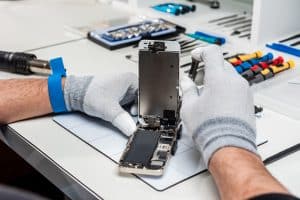
The right to repair will pave the way for a new kind of business model for manufacturers, in which they focus on selling outcomes or services rather than products.
One of the compelling use cases for the Internet of Things is the ability to provide preventative maintenance and repair — remotely, in real time, without end-user customers needing to get disrupted or even involved in the process.
But not everything with this picture is as rosy at it seems, and there may even be drawbacks with this approach. For one, there are supply chain disruptions, which may compel users to hang on to their assets longer than planned, thus requiring repairs out of the scope of the initial sales agreement. There is also the issue of vendor lock-in after the sale — in which customers may have no leverage as to how a product is serviced. John Deere, which set the standard with remote monitoring and repair of farm equipment, has faced multiple lawsuits from farmers, who allege the company has monopolized the repair service market with its onboard computers.
See also: IoT Implications? Lawsuit Alleges Lock-In Maintenance
Last year, the European Commission announced the establishment of a “right to repair,” including the right to repair after the legal guarantee has expired, and the right for consumers to repair products themselves. There has also been movement in the US, including many instances of state-level legislation and an executive order at the federal level.
“For manufacturers that once held a tight grip on how their devices can be repaired, the legislative actions present a real opportunity to bring a new sustainable business model,” says Cindy Jaudon, regional president of the Americas for IFS. “They will be welcomed by many as a significant step forwards in the transition towards a circular economy.” The right-to-repair movement “will help manufacturers transform customer relationships with servitization offerings and significantly reduce waste to benefit the environment. But in order for manufacturers to truly reap the benefits of a circular economy, they must invest in disruptive technologies that can build products and long-term customer relationships that last.”
Tomas O’Leary, president of Free ICT, also seeks to secure the right of ownership and the freedom for consumers and businesses to freely choose their providers to trade, maintain and repair products. In a world of “everything as a service,” many business models have shifted to focus on post-sales service, he said in a recent discussion with Vinnie Mirchandani of Deal Architect. “A free market is where you have could always have choice,” O’Leary says. “You always have options. You’ve got to find some way to find there’s a balance.”
At the same time, Mirchandani points out, “product companies see servitization as a way to differentiate against global competition which can rapidly commoditize core product margins. Being asked to deliver on outcome-based contracts, they increasingly want to also own the service chain. Many are not offering products for purchase but on a long term contract. Keeping ownership of the product allows them to better manage repair, refurbish and other circular economy” activities. WIth today’s global competition, anyone can copy a product in three or four years. Services, on the other hand, are much more difficult to copy, if you deliver it right, if it’s high quality.”
The right to repair may be essential if there are supply chain disruptions, O’Leary says. “If you think about it, ultimately what goes in to every piece of tech that we use are multiple raw materials, or which huge numbers are in scarce supply. We don’t have an everlasting conveyor belt of resources. You’ve got to figure out new economic models, extending the products are going to have to be having longer lives.”
Right to repair “will pave the way for a new kind of business model for manufacturers, in which they focus on selling outcomes or services rather than products,” Jaudon believes. “By providing consumers with a service after the initial transaction, manufacturers have scope to build a longer-term relationship with customers that extends far beyond the initial transaction—for example, offering regular servicing, insurance or additional capabilities.”




























